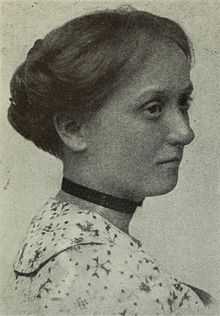Eleanor Hallowell Abbott
| Eleanor Hallowell Abbott | |
|---|---|
 | |
| Born |
September 22, 1872 Cambridge, Massachusetts |
| Died |
June 4, 1958 (aged 85) Portsmouth, New Hampshire |
| Occupation | Author |
| Language | English |
| Nationality | American |
Eleanor Hallowell Abbott (Mrs. Fordyce Coburn) (September 22, 1872 – June 4, 1958) was a nationally recognized American author. She was a frequent contributor to The Ladies' Home Journal.
Early life
Eleanor Hallowell Abbott was born on September 22, 1872, in Cambridge, Massachusetts.[1] Abbott was the daughter of clergyman Edward Abbott, who edited the journal Literary World; and the granddaughter of noted children's author Jacob Abbott.[2] Eleanor Hallowell Abbott grew up surrounded by literary and religious luminaries due to her father and grandfather. This resulted her in growing up knowing many famous literary people, like Longfellow and Lowell.[3] This caused her childhood home to be one of great religious and scholarly thought.
After attending private schools in Cambridge, she began courses at Radcliffe College.[4] After completing her studies worked as a secretary and teacher at Lowell State Normal School.[5] Here she began to write poetry and short stories, but had little success in the beginning. It was only when Harper's Magazine accepted two of her poems that she saw promise in her work. This lead to her winning three short-story prizes offered by Collier's and The Delineator.[3]
Later life and literary career
In 1908 Abbott married Dr. Fordyce Coburn and relocated with him to Wilton, New Hampshire.[6] Dr. Coburn was a medical advisor of the Lowell High School and would help his wife with her writing.[7] Soon after moving, several widely read magazines accepted her work for publication. Two of her poems were accepted by Harper’s Monthly Magazine in 1909. She went on to publish seventy-five short stories and fourteen romantic novels. Being Little in Cambridge When Everyone Else Was Big is an autobiography written by Abbott about her childhood in Cambridge.[2]
Abbott tells of how when she was a child, she was a nervous excitable one, and through her fiction, she got in touch with this side to her. This is shown greatly through her work's intensity of feeling. Her writing is one of romance and even though some of her characters go through tough and painful times, each of her novels and stories carries a happy conclusion. The principle characters that she uses are young girls that exhibit audacious behavior and are high strung, terribly talkative and full of unsettling demands. While their male counterparts are the opposite, quiet, strong, and tough against patient suffering.[3]
Abbott gives a unique style and aims for spontaneity and originality. She writes with extreme vivacity and startling imagery. Abbott would not allow her work to be published unless she truly liked it herself. Her chief concern while writing was to use her own feeling about the story she was working on.[7] Due to this unique style, many critcs comment that even though her work is charming it can feel to be sometimes forced.[3] In spite of this, Abbott's work reveals the turning away from the harshness of the New England surroundings that was in place at the time.
Abbott had no children. She died in 1958 in Portsmouth, New Hampshire.
The Eleanor Hallowell Abbott Papers are held by The University of New Hampshire Library in the Milne Special Collections. The collection primarily consists of typescripts of Abbott's short stories.[5]
Selected works

- Molly Make-Believe 1910
- The Sick-a-Bed Lady (and other tales) 1911
- The White Linen Nurse 1913
- Little Eve Edgarton 1914
- The Indiscreet Letter 1915
- The Ne'er Do Much 1918
- Love and Mrs. Kendrue 1919
- Peace on Earth, Good-will to Dogs 1920
- Silver Moon 1923
- But Once A Year: Christmas Stories 1928
- Being Little in Cambridge when Everyone Else was Big 1936
References
- ↑ Ehrlich, Eugene and Gorton Carruth. The Oxford Illustrated Literary Guide to the United States. New York: Oxford University Press, 1982: 37. ISBN 0-19-503186-5
- ↑ 2.0 2.1 "Eleanor Hallowell Abbott". Cambridge Women's Heritage Project. City of Cambridge, MA. Retrieved September 8, 2012.
- ↑ 3.0 3.1 3.2 3.3 HAMBLEN, ABIGAIL ANN. "Abbott, Eleanor Hallowell." American Women Writers: A Critical Reference Guide from Colonial Times to the Present: A Critical Reference Guide from Colonial Times to the Present. Ed. Taryn Benbow-Pfalzgraf. 2nd ed. Vol. 1. Detroit: St. James Press, 2000. 2. Gale Virtual Reference Library. Web. 11 Dec. 2014.
- ↑ "Abbott, Eleanor Hallowell". Who Was Who Among North American Authors, 1921-1939. Detroit: Gale Research Co. 1976. p. 2. ISBN 0810310414.
- ↑ 5.0 5.1 "Eleanor Hallowell Abbott (1872-1958)". Library Special Collections. University of New Hampshire. Retrieved September 8, 2012.
- ↑ "Abbott, Eleanor Hallowell." American Women Writers: A Critical Reference Guide from Colonial Times to the Present. Gale. 2000. Retrieved August 13, 2012 from HighBeam Research: http://www.highbeam.com
- ↑ 7.0 7.1 Overton, Grant Martin (1918). The Women Who Make Our Novels. Moffat, Yard & Company.
External links
| Wikisource has original works written by or about: Eleanor Hallowell Abbott |
- Works by Eleanor Hallowell Abbott at Project Gutenberg
- Works by or about Eleanor Hallowell Abbott at Internet Archive
- Works by Eleanor Hallowell Abbott at LibriVox (public domain audiobooks)

|